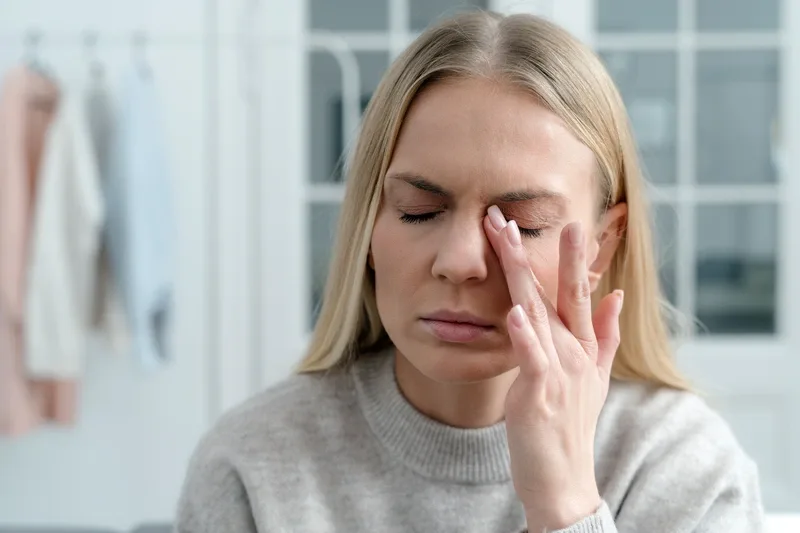Menopause brings a range of changes to the body, some well-known and others less recognized. Among the lesser-discussed symptoms is dry eye, a condition that can significantly impact daily comfort and quality of life.
While often overlooked, menopause-related dry eye can cause irritation, discomfort, and even vision disturbances. Understanding the connection between hormonal changes and eye health is essential for managing symptoms effectively and maintaining eye comfort.
Dry Eye Syndrome
Dry eye syndrome is a condition that occurs when the eyes do not produce enough lubrication to keep the surface adequately moist. A part of eye anatomy known as the tear film is composed of water, oil, and mucus and plays a crucial role in maintaining moisture and protecting the eyes from environmental irritants.(1)
When the eyes fail to produce enough tears or the tear film composition is imbalanced, symptoms such as burning, itching, redness, blurred vision, and sensitivity to light can occur. The stability of the tear film is essential for eye health, and disruptions can lead to persistent irritation and discomfort.(2)(3)
Menopause Transition and Dry Eyes
Hormonal changes during menopause affect various systems in the body, including the eyes. Estrogen, progesterone, and androgens all contribute to maintaining tear production and eye surface stability. Histamines, which regulate immune responses, may also play a role in eye irritation during this transition. Even women without a prior history of dry eyes may develop symptoms due to these hormonal shifts, highlighting the widespread impact of menopause on eye health.(2)(4)(5)

Perimenopause and Dry Eyes: A Precursor
Dry eye symptoms can begin during perimenopause, the transitional phase before menopause. During this stage, fluctuations in estrogen and progesterone levels affect various physiological processes, including tear production.(2)(6)
Many women experience initial signs of eye dryness before completing menopause, making perimenopause a critical time for recognizing and addressing symptoms early. Without intervention, these symptoms may worsen after menopause, when hormonal levels decline further.
Hormonal Fluctuations and Their Impact on Dry Eyes
Estrogen and progesterone contribute to the maintenance of healthy tear production. Decreasing levels of these hormones during menopause can disrupt the balance of the tear film, leading to increased dryness. Reduced estrogen levels affect the meibomian glands, which produce the oil necessary to prevent tear evaporation, while progesterone changes can influence the overall composition of tears.(1)(2)(6)
Histamine release can also contribute to menopausal dry eye symptoms. Fluctuating hormones can trigger an immune response, increasing inflammation in the eyes. Additionally, women with a history of dry eyes or autoimmune conditions may notice their symptoms worsen due to these hormonal imbalances.(1)(5)
Common Symptoms of Menopause Dry Eyes
Dry eyes don’t always feel just dry; they can also present with a host of other symptoms, which include the following:(1)(2)(3)
Burning or soreness in or around the eyes
Blurred vision that fluctuates throughout the day
Bloodshot or redness due to insufficient tear production, leading to inflammation
Itching or irritation, especially after prolonged screen time or in dry environments
Watery eyes or excessive tearing, as the eyes attempt to compensate for dryness
Light sensitivity, or increased reactivity to bright light, causing discomfort in sunlight or artificial lighting
Grittiness or foreign body sensation — a feeling as if something is stuck in the eye
Eye fatigue — discomfort or strain after reading or using digital screens for an extended period
Excessive blinking and/or eye twitching
These symptoms may resemble other eye conditions but are often linked to hormonal fluctuations during menopause.
Menopause and Other Eye Issues
In addition to dry eyes, menopause-related hormonal changes may contribute to other vision problems:(6)(7)
Increased risk of glaucoma and cataracts
Changes in vision clarity or the need for stronger corrective lenses
Worsening presbyopia (age-related difficulty in focusing on nearby objects)
Addressing these concerns with an eye care professional can help prevent long-term vision issues and ensure appropriate treatment.
Caring for Dry Eyes
Managing dry eyes involves a combination of lifestyle adjustments, medical treatments, and preventive measures.
Over-the-Counter Remedies
Lubricating eye drops and artificial tears can provide relief by maintaining moisture on the eye’s surface. However, those containing preservatives should be used cautiously, as frequent use may cause irritation.
Prescription Options
Healthcare professionals may recommend prescription treatments, such as anti-inflammatory eye drops or short-term steroid therapy, to reduce irritation in more severe cases. The medication prescribed depends on symptoms and the underlying cause.
Natural Remedies
Dietary changes, including increasing omega-3 fatty acids through fish or flaxseed and consuming foods rich in vitamins A + E, B vitamins, and lutein, may help promote tear production. Drinking enough water daily and using a humidifier can also help maintain eye moisture.(3)
Hormone Replacement Therapy (HRT)
HRT is a potential option for managing menopause-related symptoms, including dry eyes. Some studies suggest that HRT may help improve tear production and eye lubrication by stabilizing hormone levels.(2)(5)(6)(8)
While research on its effectiveness varies, many individuals report relief from dry eye symptoms with HRT. A healthcare provider can help determine whether HRT is a suitable option based on individual health needs.
Preventive Measures and Lifestyle Changes
Avoiding Dry Environments: It’s important to minimize exposure to air conditioning, strong winds, and smoke to protect the eyes from dryness.
Taking Screen Breaks: Blinking regularly and minimizing screen time are essential for eye health. Looking at
something 20 feet away for at least 20 seconds every 20 minutes, known as the 20-20-20 rule, may also be beneficial.(9)
Maintaining a Healthy Diet and Hydration: Consuming foods rich in essential vitamins and staying well-hydrated can support eye health.(3)
Managing Stress and Exercising Regularly: Physical activity and stress reduction techniques may help mitigate menopausal symptoms, including dry eyes.
Using Protective Eyewear: Sunglasses with UV protection and wraparound designs can help reduce irritation that may result from wind and sun exposure.
Scheduling Regular Eye Exams: Routine check-ups help detect and manage dry eyes and other menopause-related vision issues.
When to See a Doctor for Dry Eyes
Consulting a healthcare provider is important if any of the following occurs:(3)(1)
Dry eye symptoms persist despite over-the-counter treatments
Vision becomes increasingly blurred or difficult to maintain
Eye pain, redness, or discomfort that worsens over time
Other symptoms, such as joint pain or fatigue, may suggest an underlying autoimmune disorder (e.g., Sjögren's syndrome).
Seeking guidance from an eye care professional will ensure appropriate treatment and long-term eye health.
Dry eye during menopause can be uncomfortable, but relief is within reach. From artificial tears to omega-3s and hormone replacement therapy, there are many ways to restore comfort and protect eye health. Clear, comfortable vision is possible — menopause may bring changes, but the future doesn’t have to be dim.
Struggling with dry eyes during menopause? Discover if HRT is the right option.
If you’ve entered the menopause transition and are dealing with uncomfortable dry eyes, you’re not alone. Take our brief menopause quiz to see if you’re an eligible candidate for HRT. Get started with Winona to take the first step toward feeling better.
